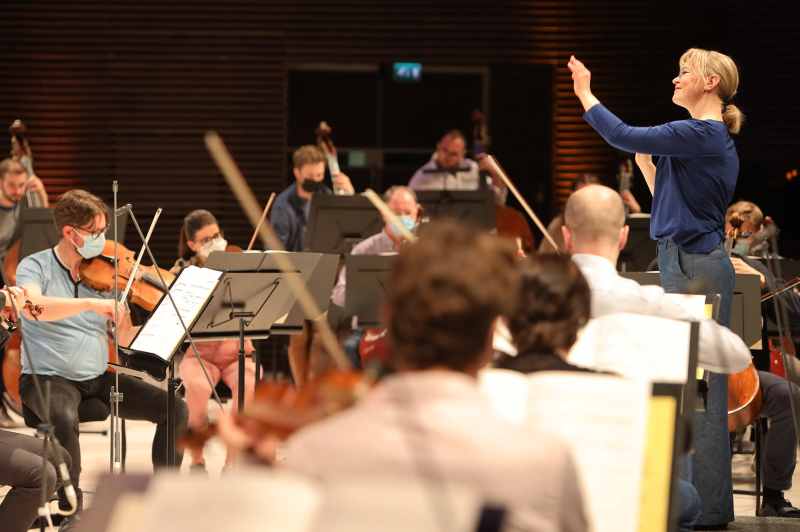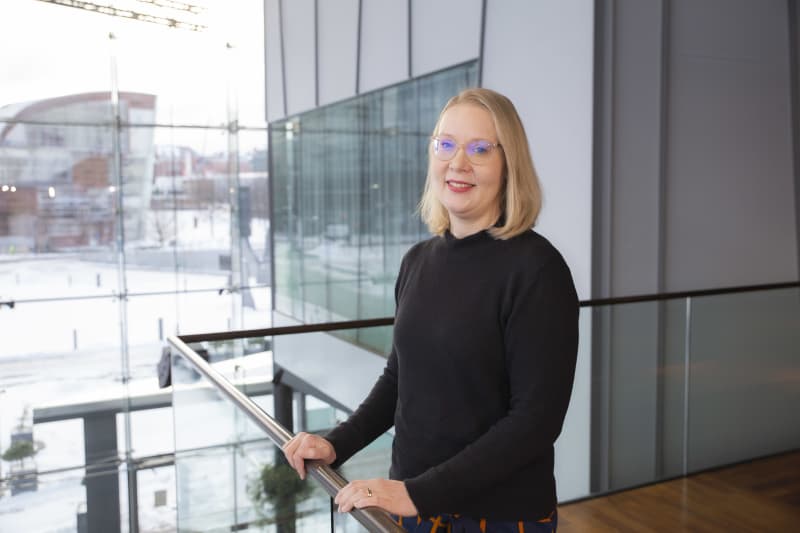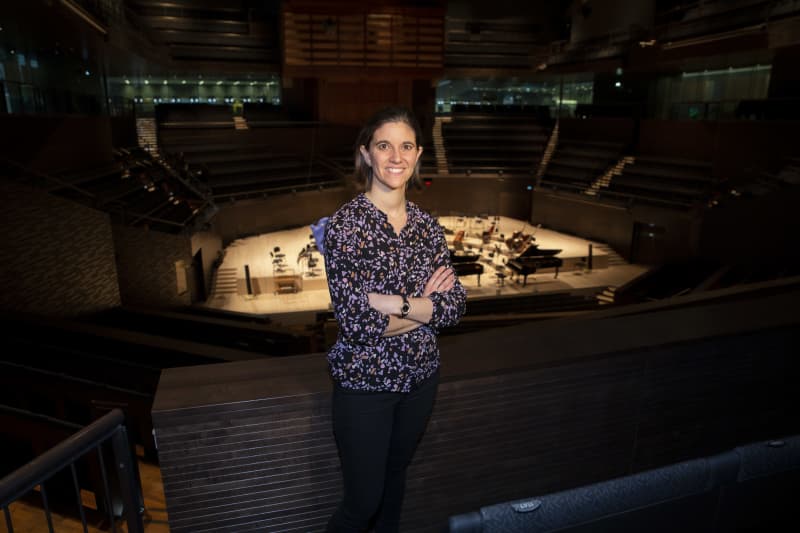
Yle found out the gender distribution of composers, conductors and soloists for the current year. In the light of the statistics, music life is anything but diverse.
About nine and a half percent. That’s how many of the names of composers appearing in the concert programs of Finnish symphony orchestras are women.
This is evident from Yle’s report, which calculated the gender distribution of composers, conductors and soloists in concert music in 2022. In total, Yle counted ten symphony orchestras and six smaller ensembles.
The statistics show that alongside one piece composed by a woman, on average nine works composed by men are heard in Finland.
In terms of the variety of music heard at concerts, the situation is quite disconcerting, and in some places it has been noticed that something should be done about it. In recent years, there have been projects to find music composed by women in the pages of history, for example, the Helsinki City Orchestra launched a project called \”History’s forgotten orchestral music\” a year and a half ago.
Outside the capital region, we are below the average
The Helsinki City Orchestra, the Radio Symphony Orchestra and the Tapiola Sinfonietta, which participated in HBL’s comparison, have taken a couple of steps forward in recent years, but based on the gender distribution, it is still not possible to talk about the genuine diversity of the music being performed. More music composed by women than average – but still very little – has been heard and will be heard in Lahti this year as well.
Other Finnish symphony orchestras included in Yle’s survey were Jyväskylä Sinfonia, Kuopio City Orchestra and Kymi Sinfonietta. As a rule, outside the capital region, the gender distribution is below the average.
In Yle’s survey, the extremes are found in smaller ensembles, core and chamber orchestras. In terms of the gender distribution of composers, Avanti, which specializes in new music, is by far at the top of the statistics, while the Helsinki Baroque Orchestra will not perform a single piece composed by a woman in 2022.
Today it is already known that there are also interesting female composers from the Baroque era. The Finnish baroque orchestra had found a few pieces in its repertoire.
Even in the best case, we are far from true diversity
– It is important to start from the premise that no one should be selected as a composer, conductor or soloist based on their gender, whether they are men or women or others. At the same time, it is absolutely justified to pay attention to the fact that the repertoire contains much more music composed by men than by women.
The statistics show that the HKO and the other symphony orchestras that played the most music composed by women this year are still far from true diversity, despite the talk.

First of all, according to Malmberg, the question is about the mission of the symphony orchestra and the related legalities.
– Our mission is to keep the 250-300-year history of Western art music alive, awake and always alive again.
Over the past centuries, Western society has been anything but egalitarian. When picking composers from history, you usually end up with a man, unless the aim is specifically to find women.
– We cannot escape the fact that in the 19th century and the beginning of the 20th century, women did not have the same opportunities to work as composers as their male colleagues.
Several projects have been launched recently, the purpose of which is to find music composed by women that has been lost or forgotten for one reason or another. Laura Netzel’s *piano concerto* has also been mentioned before, the orchestral version of which was not performed during the lifetime of the composer, who was born in Finland and moved to Sweden as a child. The work, completed in 1897, had its first performance in Sweden only in 2020 and its second performance now in Helsinki.
Secondly, according to Malmberg, it is about the gender distribution of composers today. In part, the orchestras are appealing, even today, to the fact that there is no music composed by women.
– Most of the composers who graduate from the Sibelius Academy are men. It would be strange to think that half of the music performed should be from women for the sake of equality.
There are currently 20 male and 6 female undergraduate students majoring in composition at the Sibelius Academy. So 23 percent of that group are women. HKO’s 12.5 percent is far from that, but on the other hand, it conforms quite closely to the gender distribution of the members of Suomen säveltäjät ry. 12.7 percent of its members are women.
The number of examples is decisive
– But I think the machine would have to be pushed in some direction in order to bring about change, he states.
The situation is made difficult by the phenomenon’s complex cause-and-effect relationships. The number of role models has a significant impact on what people do.
The low proportion of women composers may be partly the result of a kind of vicious circle. How can we get more female composition students and composers, if music composed by women is rarely heard in concert halls? Of course, a woman can experience a man as a role model, but a woman may also experience otherness in a field dominated by men.
– It is also important to take backgrounds into account when teaching and making teaching materials. You can make the materials so that there are different types of composers from different backgrounds as examples.

Hynninen has led group lectures at universities in, for example, California, USA. There were students from different parts of the world. In Hynnien’s opinion, it would have been strange to use only white men as examples of composers.
– I think that a composer with a Chinese background works better for students with a Chinese background. Otherwise, you might feel like you’re watching an exhibition: I’m the viewer, there are the creators.
Hynnin once got acquainted with composing at the Department of Musicology at the University of Helsinki. Composition lessons were offered.
– I immediately thought that I had to go there and have a look. There were 10-15 students there and I happened to be the only female. It made me feel like, oh, am I in the right place, Hynninen says.
– Heininen made me forget the gender of composing. I only got into it as a composer.
\”I started to understand that I am not mainstream because of my gender\”
If the music played in the orchestra’s repertoire is rarely composed by a woman, the conductor is also rarely a woman, show the statistics prepared by Yle.
From the speeches of Chloé Dufresnes, who led the HKO concert last week, you can get an idea that women are attracted to each other when it comes to programming orchestras.
– I conduct a lot of works composed by women, and I am also asked for a lot of such repertoire.
Dufresnes did not raise the matter as a problem, but the phenomenon was also partially revealed in the material collected by Yle. Often the Visiting Female Conductor conducts at least one work composed by a woman. A woman in a prominent part of the concert repertoire often grows as if it were one of the themes of the concert.
Against this background, Aleksi Malmberg’s words about artist selection based solely on merit are at least not entirely true.
Equally, the profile of women in the field of classical music rises when women get to appear in concert programs.
– When I was studying in Helsinki, my gender was never questioned. While working in France, I began to understand that I am not in the mainstream of conductors because of my gender, says 29-year-old Dufresnes.

Regarding the gender distribution of soloists, according to Yle’s report, the situation is the most diverse:
\”Impossible to imagine a music life that would freeze in place\”
From an individual’s point of view, the idea is beautiful, but statistics show that the mechanisms preventing diversity in the classical music industry are deep in the industry’s structures. And it is diversity that helps classical music improve its chances of remaining a significant art form in the future.
– If we are not able to change along with the surrounding society, the industry will wither and become irrelevant, says superintendent Aleksi Malmberg.
– HKO exists for the people of Helsinki, and people from different parts of Finland and the world have moved here. Our task is to try to find music from the orchestra’s tradition and today, which comes close to people and speaks to them. That is one of the basic reasons why music should be diverse.
The diversity and polyphony of music are, at least on paper, something that the Helsinki City Orchestra should aim for, but the statistics don’t lie. In practice, there is still a long way to go to achieve the goal.
When Suomen Sinfoniaorkesterit ry started collecting statistics on gender distribution a few years ago, Malmberg thought that setting annual target numbers was not appropriate.
– Instead, you have to get behind the numbers. Why are they the way they are, and on what basis are artistic designs made? It is impossible to imagine a music scene that would freeze in place. The change will probably continue at an accelerating pace from now on, Malmberg states.
Perhaps. But in the light of the statistics, the classical music industry, which uses public money, is currently standing still in many parts and in many places in Finland.
*Yle gathered the information for the report from the Finnish Symphony Orchestras’ concert calendar and the orchestras’ websites. There were some deficiencies in the data, but the deficiencies do not change the overall picture.*
*You can read more about calculation methods and the background of the story project* in this article.
*You can discuss the topic until Thursday at 11 pm.*
